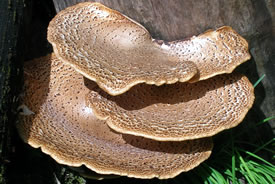The forgotten art of gathering wild food

Oyster mushroom (Photo by Jim Tunney, Mushroom Observer, Wikimedia Commons)
As I delve deeper into my own journey as an organic gardener, I come across many interconnected subjects that pique my interest. The art of foraging is just one of them.
Historically our ancestors gathered food locally for both edible and medicinal purposes, all of which can be easily found in our natural landscape. Recognizing these wild foods and knowing how to use them is an important part of foraging.

Dryad's saddle (Photo by Rosser1954, Wikimedia Commons)
Above all else, the number one rule to keep in mind when foraging is: if you're not 100 per cent sure, don’t gather it.
I personally like to have a reference guide with me when I go foraging. The book by Andrew Mackinnon Edible & Medicinal Plants of Canada is just one of the great resources you can use to ensure your well-being. However the best resource is always an expert, especially when it comes to mushrooms!

Morels (Photo by Johannes Harnisch, Wikimedia Commons)
In early spring my cousin and I went on a mushroom foraging expedition in the Don Valley Parkway accompanied by two experts. Chef Scott and mycologist Grant Bouchard guided us on this trip held by The Culinary Adventure Company.
Armed with a broken stick and my little basket we trekked into the woods to look for morels, Dryad's saddles and baby greens such fiddlehead ferns. A morel is a rare edible mushroom that looks like a honeycomb cup and is highly prized in French cuisine, whereas a dryad's saddle is widely found attached to dead logs or stumps.

Invasive garlic mustard, Clear Creek Forest, Ontario (Photo by NCC)
Grant taught all of us an important key points when it comes to foraging: always make sure that you have permission to access an area and gather food there, whether it be in a neighbour's backyard or close to a public park, as there maybe certain restrictions. It's also a good idea to forage sustainably — don't remove everything you find, especially if it's native. But if it's an invasive species, the more, the better!
I came out of that trip with a fresh new zeal to learn more about foraging. My little basket was full of edible greens such as poor man's mustard (also known as garlic mustard — an invasive species) and dryad's saddles.
Sadly I did not find a true morel. I did however get a false one and my foot into an ant's nest.
If you're interested in learning how to forage I would highly recommend a similar trip. With a knowledgeable guide and long jeans, this could be the fun fall trip you and your family have been scavenging for!


